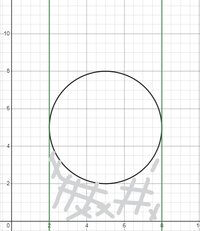what I mean by one-to-two curve is that the curve has 2 y value outputs for a single x value input.
As an example of this problem I have attached an image to illustrate what I mean. The equation of that circle is
[math]9 = (x-5)^2 +(y-5)^2[/math]and I am trying to formulate an integral to compute the greyed area. (no synthetic geometric approach allowed)
so naturally I figured I should make y the subject and do the definite integral and got:
[math]y=\sqrt{9-(x-5)^2}+5[/math]
My point of confusion however is: which y value will this give ?
the higher one or the lower one? if it is the higher one, then in my integral the area computed will include both the entire circle and the grey area.
if its the lower one well thast great but how do I make sure I have found the correct y(x) relation that will only give me the lowest of the y values in a one-to-multiple cartesian curve? thanks
(note: the image is not a problem I am just using it to illustrate my question)

As an example of this problem I have attached an image to illustrate what I mean. The equation of that circle is
[math]9 = (x-5)^2 +(y-5)^2[/math]and I am trying to formulate an integral to compute the greyed area. (no synthetic geometric approach allowed)
so naturally I figured I should make y the subject and do the definite integral and got:
[math]y=\sqrt{9-(x-5)^2}+5[/math]
My point of confusion however is: which y value will this give ?
the higher one or the lower one? if it is the higher one, then in my integral the area computed will include both the entire circle and the grey area.
if its the lower one well thast great but how do I make sure I have found the correct y(x) relation that will only give me the lowest of the y values in a one-to-multiple cartesian curve? thanks
(note: the image is not a problem I am just using it to illustrate my question)

